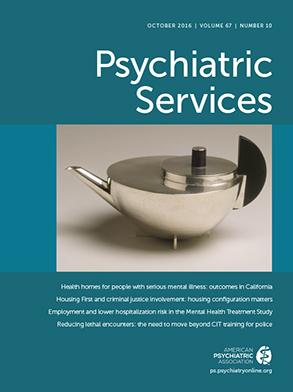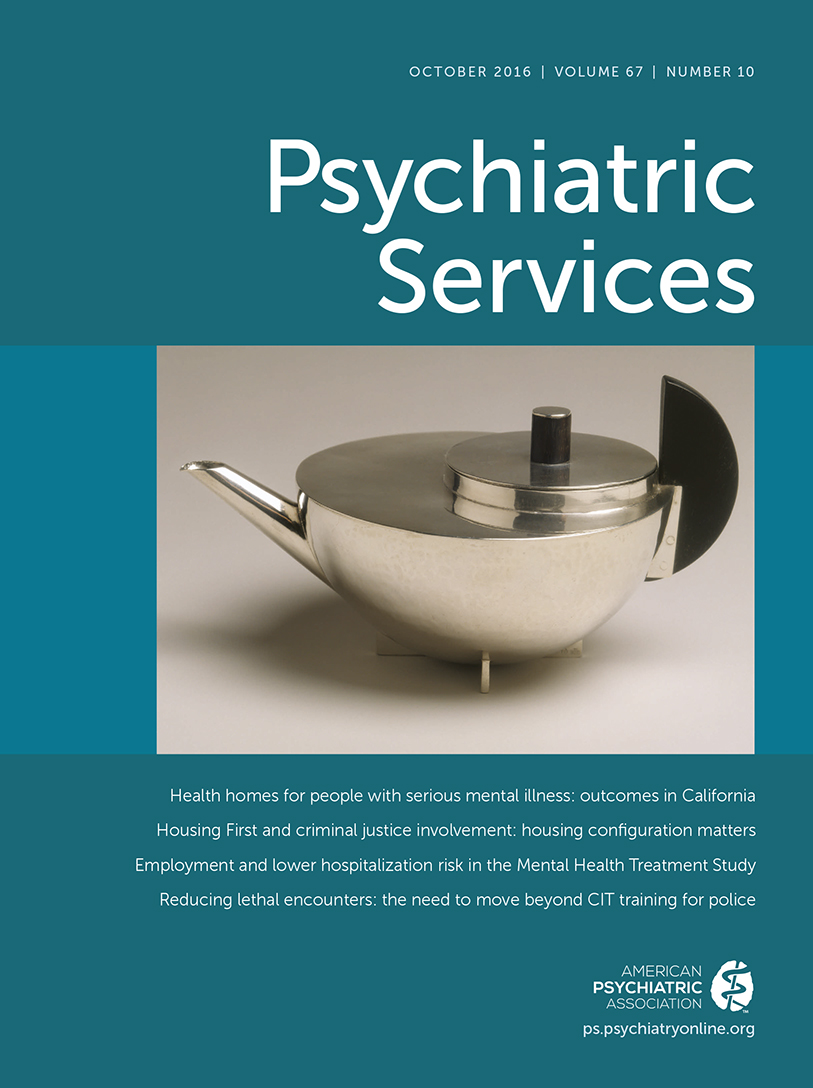In 2011, reports of increased psychotropic use among Medicaid-insured youths and failure to meet best-practice guidelines precipitated a major national political movement to closely examine psychotropic treatment of publicly insured youths (
1,
2). In response to the mandates following these reports, many states adopted a prior authorization process to monitor psychotropic use (
3). In fact, prior authorization is used more frequently than other utilization management methods, such as preferred drug lists, to contain costs and to monitor the quality of care (
4). Previous studies have reported a decline in antipsychotic use secondary to state Medicaid prior authorization policies, but the impact on patients’ use of health services and other treatments is poorly understood (
5).
Understanding the similarities and differences in implementation of psychotropic-monitoring programs will be important for establishing evidence of best practices. First, the impact on psychotropic prescribing, which may be one metric of program effectiveness, likely differs by program implementation. Second, it is important to identify key factors that contribute to practice changes. Third, this information will shed light on valid and reliable measures of change in psychotropic utilization. The purpose of this study was to gather detailed information about state Medicaid program implementation strategies for the oversight and monitoring of psychotropic use among Medicaid-insured youths to better assess similarities and differences across programs at the time when federal recommendations were promulgated.
Methods
A telephone survey, administered from August 2011 through December 2012, assessed state Medicaid psychotropic-monitoring programs targeting youths. The sampling frame included state Medicaid directors or their designee in all 50 states and the District of Columbia. Medicaid directors’ names and e-mails were identified via Web sites or through referral from other state Medicaid directors. Because the survey was anonymous, the protocol was deemed exempt by the University of Maryland Institutional Review Board.
The survey, which is available on request, included 12 questions about the program characteristics and implementation strategies. Categorical-response questions about program characteristics included the existence of a formal written policy or guideline (yes or no), factors influencing program development (for example, cost, best practices, law suit, legislation, or public concern), ongoing periodic review (monthly, quarterly, biannually, or annually), and the professional involved in the review or oversight (for example, child psychiatrist, psychologist, pharmacist, nurse, or primary care clinician). Respondents also reported “red flags” that would warrant a case for further review: the target population (Medicaid, foster care, child welfare, or other), psychotropic class (all psychotropic classes, antipsychotics, antidepressants, mood stabilizers, or stimulants), concomitant use (three, four, or five or more classes), indication for use (for example, off label, no diagnosis to support use, or inconsistent with current guidelines), and prescriber credentials. Open-ended response options included implementation date for the new program and the ages targeted. One open-ended question solicited information on program implementation strategies.
Medicaid directors or their designee were invited by e-mail to participate, and up to four e-mails were sent to nonresponders. Telephone surveys were completed in 30 to 60 minutes with the key informant most knowledgeable about the program. The principal investigator (SdR) or a trained graduate research assistant administered the survey. Within six to 12 months of completing the survey, respondents were e-mailed a summary of their state-specific information and were asked to verify the accuracy and provide updated information if anything had changed.
Survey responses were entered into an Excel database and converted to SAS, version 9.3, for analysis. The open-ended responses about program implementation strategies were classified by type of program on the basis of key aspects of the implementation process. Data are presented as descriptive frequencies of the program characteristics and implementation strategies.
Results
Key informants from 42 states responded to the e-mail invitation, for an 82% response rate. Four declined participation. The remaining 38 participants were located in the South (N=12, 32%), West (N=11, 29%), Midwest (N=10, 26%), and Northeast (N=5, 13%). At the time of the survey, key informants from 28 of the 38 states (74%) reported having a psychotropic-monitoring program in place, and ten (26%) reported programs in development. The 28 states with existing monitoring programs are the focus of this report.
Sixteen of the 28 state programs (57%) were newly initiated in 2011 or later, following the federal reports, and were motivated by best practices (N=24, 86%), public concern (N=16, 57%), and cost (N=13, 46%). The earliest program was implemented in 2005. Many states (N=19, 68%) partnered with a university or the managed care vendor to conduct the review (
Table 1). Over half (54%) had a one-tier review process, mainly a pharmacist. A child psychiatrist was a second-tier reviewer for appeals, and a Medicaid medical director often was a third-tier reviewer. In most programs, the medication was not dispensed while the case was under review, with allowable exceptions for crisis situations or following institutional discharge. Most programs (N=20, 71%) required an annual or biannual periodic review for youths receiving ongoing treatment. Models for monitoring strategies included prior authorization, retrospective database review, and a consultation model.
Nineteen of the 28 (68%) state Medicaid administrations adopted prior authorization requiring a formal review and approval before the medication could be dispensed. Monitoring strategies that used prior authorization varied in that three of the programs were embedded in existing state Medicaid drug utilization review programs, and three had provider consultations as part of the review. Fourteen of the 19 prior authorization programs used an external organization to conduct the review—that is, a vendor or university contracted by Medicaid. In ten of the 19 programs, a pharmacist reviewed the prior authorization request, and nine programs had a multitier review process that included a pharmacist and a child psychiatrist.
A retrospective database review of pharmacy claims was implemented in seven of the 28 states (25%). Anywhere from monthly to one-year retrospective reviews were conducted to identify prescribing patterns warranting further inspection. A drug utilization committee, a pharmacy and therapeutics committee, or a quality assessment committee often conducted such reviews.
Two of the 28 states (2%) implemented consultation programs, which involved a child psychiatrist review. This occurred in real time in one state and originated within the Medicaid administration. The other consultation model was a 60-day retrospective review conducted by a group that was external to the Medicaid administration.
Age or psychotropic drug class was a key criterion for initiating a review (
Table 1). For 11 of the 28 states (39%), the psychotropic program focused on the youngest children (0–6 or 0–8 years). Nearly all 28 states monitored antipsychotic use (93%), and 11 of the 28 states (39%) targeted all psychotropic drug classes. A psychotropic regimen involving three or more therapeutic classes was a criterion for review in seven of the 28 states (25%).
Discussion
Variability across and within the types of state Medicaid psychotropic-monitoring programs was observed. The most common model was prior authorization, and some of these programs were integrated within states’ existing drug utilization review teams. Access restriction resulting from prior authorization is a potentially important consideration when evaluating program effectiveness. Moreover, monitoring programs focused primarily on antipsychotic medications and mainly targeted youths age 18 and younger. Pharmacists and child psychiatrists played a key role in psychotropic-monitoring programs. The findings are discussed below in relation to clinical practice and future evaluation of policy impact and program effectiveness.
Programs in several states focused exclusively on antipsychotics. Thus it will be important to monitor the use of other psychotropic medications that may be prescribed as an alternative. Balancing restrictions that affect an entire therapeutic class without limiting access for youths with a clinical need for treatment is critical (
6). Notably, this may have a differential impact for specific subgroups, such as youths in foster care, who have higher rates of antipsychotic use than other Medicaid-insured youths (
7).
It will be essential to determine the policy impact on more judicious prescribing that is aligned with practice parameters and better quality of care. Some initial outcomes include a 64% decrease in polypharmacy over a six-year period (
8). A recent report on Vermont’s experience noted that only 50% of antipsychotic prescribing followed best practice as defined by the American Academy of Child and Adolescent Psychiatry practice parameters (
9). The lack of metabolic monitoring was the main reason that prescribing did not meet best-practice standards (
9).
The study was limited in several ways. Despite the outreach to the 50 states and the District of Columbia, nine states did not respond and four states refused to participate, which limited our ability to fully evaluate the national response to the federal mandate. The survey included only key informants from state Medicaid administrations, and thus the findings do not reflect psychotropic monitoring that may be conducted through child welfare agencies. Although this study did not collect information on provider outreach, this is a tremendous opportunity for educating the medical community on practice guidelines and available resources to assist providers in managing the care of youths. A strength of this study was that we provided key informants with a summary of the program description for their state to verify the accuracy of the information and to update the survey data as needed.
Conclusions
Psychotropic-monitoring programs have bridged state-academic partnerships to implement federal policy. There is continued federal interest in monitoring psychotropic use, and state agencies may be asked to report on the impact of monitoring programs. Evaluating the impact of psychotropic monitoring on prescribing practice changes will need to account for the key factors that vary across and within different models. This information will inform future comparative effectiveness studies that can be designed to evaluate whether the oversight tactic (that is, prior authorization or consultation models), multitiered review, psychotropic class targeted, or some other program component has the largest impact on best practices, quality of care, and youth outcomes.
Acknowledgments
The authors are grateful to Lauren Wagner, Ph.D., Donnetta McFadden-Coleman, Pharm.D., and Zhongyuan Zhao, Pharm.D., for assistance with data collection and database management. The authors also thank Kamala Allen, M.H.S., and David Goffman, Pharm.D., for assistance in the early stages of the survey development and outreach.

